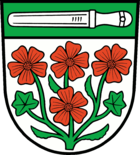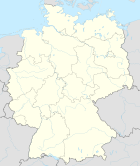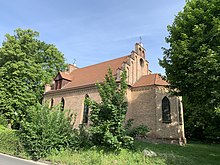Schulzendorf
| coat of arms | Germany map | |
|---|---|---|

|
Coordinates: 52 ° 21 ' N , 13 ° 36' E |
|
| Basic data | ||
| State : | Brandenburg | |
| County : | Dahme-Spreewald | |
| Height : | 43 m above sea level NHN | |
| Area : | 9.1 km 2 | |
| Residents: | 8441 (Dec. 31, 2019) | |
| Population density : | 928 inhabitants per km 2 | |
| Postal code : | 15732 | |
| Area code : | 033762 | |
| License plate : | LDS, KW, LC, LN | |
| Community key : | 12 0 61 444 | |
| Community structure: | 4 districts | |
| Address of the municipal administration: |
Richard-Israel-Strasse 1 15732 Schulzendorf |
|
| Website : | ||
| Mayor : | Markus Mücke (independent) | |
| Location of the community Schulzendorf in the district of Dahme-Spreewald | ||
Schulzendorf is a municipality in the Brandenburg district of Dahme-Spreewald on the outskirts of Berlin .
geography
The Schulzendorf community is located on the south-eastern outskirts of Berlin. To the northeast lie Eichwalde and Berlin-Schmöckwitz , to the west the community Schönefeld (district Waltersdorf ) and southeast Zeuthen . The major construction site for the new Berlin Brandenburg Airport is located west of Schulzendorf .
Community structure
Schulzendorf has no officially designated districts or inhabited districts. Neuschulzendorf and Eichberg housing estate are designated as living spaces.
The municipality consists of four different settlement bodies:
- the old village center Alt-Schulzendorf , where, however, no further settlement development took place and which is therefore a well-preserved Brandenburg village complex surrounded by open spaces - now protected .
- the Eichberg settlement in the north, which merges seamlessly into the neighboring municipality of Eichwalde,
- the Schulzendorf-Mitte settlement between Ernst-Thälmann-Strasse and Ebbeschaben, and
- the Neu-Schulzendorf settlement in the southeast, which merges into the Zeuthen community without any recognizable border.
There is no natural or artificially created town center. The municipal administration has been based in the new town hall in the center of the town since 2009.
history
14th and 15th centuries
The place was first mentioned in a document in 1375 in the land book of Charles IV as Schultendorpp and Scultendorf , but was probably already settled by Ascanians before . At that time, Schutendorpp comprised 47 hooves , four of which were intended for the pastor and another 12 free hooves by Heinrich Reichenbach. Each farmer had to pay him four bushels of rye, four bushels of oats as lease, two shillings in interest and nine pfennigs in terms of rent . Reichenbach continued to have the church patronage , so that - in connection with the parish hooves - there must have already been a simple wooden church at that time. It was probably replaced by a stone church in the 13th or 14th century . In addition to the income mentioned, there were two shillings that the eight kötter had to pay and ten shillings of income from the jug . In 1414 the place came into the possession of the Bardeleben family and from there around 1450 to the Storkow family via the village and 33 wild Hufen. A lock register from 1450 shows 55 hooves, presumably including the fawns. During this time the spelling Schultendorff appeared for the first time , which changed to Schultzendorff in 1624 and Schulzendorf in 1775 . The pastor was still entitled to four hooves. In 1451 a shepherd appeared for the first time. Around 1480, until after 1507, Schulzendorf came to the Diricke family via the village.
16th and 17th centuries
In 1507 the Diricke family handed over Schulzendorf with all rights to Otto Britzke , who passed it on to the von Kahlenberg family before 1542. They lasted until the Thirty Years' War . In 1625 eight hoofers, six kötter and one shepherd lived in the village. There was not yet an own forge; if necessary, a blacksmith came by. The area was 35 hooves in size, plus twelve rule hooves. One hoof came off the farmer's hooves, which the von Kahlenberg family approved in 1622. After the war, only six farmers and two sons lived in the village. The von Kahlenbergs had meanwhile resold the knight's seat in 1648 to the von Rochow family , who passed it on to Frau von Gersdorf (widowed von Pfuhl) in 1692. From there, the von der Liepe family, as guardians of the von Kahlenberg family, received the right to resell in 1698. They were with the manor invested . In addition to the knight's seat, this consisted of a brewery, a barn, stables, gardens and a dairy. The estate was 35 schossbare hooves large, it was a freigewilligt. The manor was 14 hooves in size, plus a church hoof and four parish hooves. The residents had sheep farming justice. There was a shepherd's house with a garden, eight house people, including a carpenter, a mare, a linen weaver, two sextons and two widows.
18th century
In 1711 there were five hoofers, four kötter, a shepherd, a blacksmith, a shepherd and a large and a small farmhand living in Schulzendorf. You gave eight groschen for the 34 hooves. From 1718 to 1812 the place was owned by the Hohenzollern family . During this time in 1745 six farmers and five kötter lived in the village. There was a forester's house and a windmill, and a sheep farm outside the village. In 1771 there were ten gables (= residential houses) in the village. There was a blacksmith, a shepherd, four couple of householders, a shepherd, a foreman and a small farmhand. In 1773 a private windmill appeared for the first time.
19th century
In 1801 the place had grown to six whole farmers, five Ganzkötter and four residents. There was a windmill and an official farm ; Schulzendorf consisted of 34 fire places (= households). The name Schulzendorf was first handed down from this time in 1805. In order to settle debts, the House of Hohenzollern sold the town in 1812 for 31,586 thalers to the Prussian Minister of State Freiherr von der Reck. In 1858 craftsmen erected the first school building, and from 1865 to 1866 the Schulzendorf patronage church . In 1858 there were 13 farm and estate owners in the village and manor who employed 35 servants and maids as well as twelve day laborers. There were also four part-time farmers and six workers. There were 14 servants and 17 possessions. The manor was by far the largest with 1304 acres. Eleven other farms were between 30 and 300 acres (together 1724 acres), three more between five and 30 acres (together 84 acres) and two together two acres. A master shoemaker, a tailor, a carpenter's apprentice, a roofer journeyman and a poor man lived in the village. In 1860 there were two public, 18 residential and 37 farm buildings in there and in the forester's house, including a flour mill. The estate consisted of nine residential buildings and 17 farm buildings as well as the protection area and forest ranger's house adjacent to the village. In the manor district of Königs Wusterhausen Forest there was still one residential and one farm building. Moritz Israel acquired the manor in 1888. In 1889 he built a mansion in the neo-renaissance style . Two years later he gave the wedding gifts to his son Richard and his wife Bianca Cohn.
20th century
At the beginning of the 20th century, farmers began to parcel their lands. They sold the land to interested parties, preferably from Berlin, who wanted to settle in Schulzendorf or have a weekend house built there. In the course of this settlement, the owner of the Schulzendorf manor, Richard Israel, also decided to sell some of his land. This is how the Neuschulzendorf residential area was created. Further new buildings were built, especially in Mitte and Eichberg; the historic Altdorf was less and less frequented. The number of buildings, on the other hand, rose from 25 houses in the village and five in the estate to a total of 174 residential buildings in 1931. In 1911 the manor was connected to electricity and a central drinking water supply. In 1928 the Schulzendorf estate was merged with the community. In 1932, in addition to the community, it consisted of the Eichberg, Neu Schulzendorf colony, Schulzendorf forest house and Schulzendorfer Schäfereivorwerk.
During the National Socialist era , the Israel family was forced to leave the manor. Some members of the family were deported . After the end of World War II , 133 hectares were expropriated and 79 redistributed. 28 farmers received a total of three hectares, four farmers received a total of six hectares and new farmers received a total of 70 hectares. The increasing urban sprawl also means that leading church in the years 1951/1952 Kreuzkirche Schulz village had built. Seven farmers joined together in 1955 to form a Type I LPG with 49 hectares, which was converted into a Type III LPG in 1957. In 1960 there was the LPG type III with 40 members and 311 hectares. In 1971 it was merged with de LPG Waltersdorf to form LPG Schulzendorf-Waltersdorf. In 1973 there was VEB Innenbaukunst Eichwalde with its Schulzendorf plant and the aforementioned LPG.
In 1979 the patronage church closed; her organ was brought to the Kreuzkirche in 1979. In 1999 a support association was founded, which has taken care of the patronage church and the reconstruction of the historic village green since then. In 2000 the place celebrated its 625th anniversary.
Population development
|
|
|
|
|
Territory of the respective year, number of inhabitants: as of December 31 (from 1991), from 2011 based on the 2011 census
politics
Community representation
The community council consists of 18 community representatives and the full-time mayor. The local election on May 26, 2019 resulted in the following distribution of seats:
| Party / group of voters | Seats |
|---|---|
| The left | 3 |
| Alliance 90 / The Greens | 3 |
| SPD | 3 |
| AfD | 3 |
| CDU | 3 |
| Citizens' alliance of free voters | 2 |
| FDP | 1 |
mayor
- 1994–2010: Herbert Burmeister (Die Linke)
- since 2010: Markus Mücke (independent)
Mücke was elected the new mayor in the runoff election on October 11, 2009. In the mayoral election on October 15, 2017, he was confirmed in office for another eight years with 53.7% of the valid votes.
coat of arms
The coat of arms was approved on October 12, 1995.
Blazon : "Under a green shield head, covered with a silver Schulzen staff , a green mallow branch with four (3: 1) red flowers."
The community of Schulzendorf chose a talking symbol for its coat of arms, the Schulzen staff, which refers to the place name in the sense of the heraldic pars-pro-toto principle. The stylized mallow plant with its four flowers stands for the grown structure of the place with four parts of the settlement. The arrangement of the flowers symbolically represented the old village as the starting point for this development. The mallow blossoms symbolize the character of the community as a garden city at the gates of Berlin. The mallow (Malva sylvestris), a perennial up to 120 centimeters high, occurs both in the garden and in the open ground and thus also symbolizes the embedding of the community in the Brandenburg landscape.
flag
The flag of the municipality shows stripes in the colors green and white with coats of arms. The coat of arms is placed directly in the middle of the flag.
Partner communities
The Prague district of Vinoř (in the 19th district ) is located on the northeastern city limits of the Czech capital and has around 3,000 inhabitants. He has been Schulzendorf's partner community since 2007.
In 2009 another partnership was established with the small Polish town of Kargowa . The Mayor of Schulzendorfer Markus Mücke was made an honorary citizen of Kargowa in 2017 .
Attractions
The respective cultural monuments are listed in the lists of architectural monuments in Schulzendorf and the ground monuments in Schulzendorf .
- Schulzendorf Castle, a former manor house and the Schulzendorf village church are located in the old village of Schulzendorf .
- In front of the former town hall on Otto-Krien-Straße there is a memorial stone from 1982 in honor of the resistance fighters against National Socialism . The memorial stone was moved and restored in 2012, it is now in front of the Schulzendorf sports and multi-purpose hall in Walther-Rathenau-Str.
- The Kreuzkirche Schulzendorf is a hall church from 1952. Inside there is an organ from the patronage church in Alt-Schulzendorf.
- The Flutgrabenaue Waltersdorf nature reserve is located southwest of Schulzendorf .
Economy and Infrastructure
traffic
The federal highways A 113 and A 117 run immediately to the west and north-west of the municipality. The closest junction is Waltersdorf on the A 117.
Ernst-Thälmann-Strasse, Miersdorfer Strasse and Dorfstrasse / Waltersdorfer Chaussee are designated as district roads . Dahlwitzer Straße on the southern border of the municipality is part of the Brandenburg state road L 402 between Dahlewitz and Zeuthen .
The closest connection to rail traffic is the Eichwalde S-Bahn station , which also opens up the Schulzendorfer Eichberg settlement.
In 1931, the Dahmetal bus company set up regular bus services for the first time in Schulzendorf .
education
There is a primary school in town. The next high schools are in Eichwalde, Wildau and Königs Wusterhausen . In Zeuthen there is a comprehensive school with an upper level.
Personalities
Sons and daughters of the church
- Volker Fadinger (* 1941), ancient historian, born in Schulzendorf
Personalities associated with the community
- Alfred Mühr (1903–1981), journalist and writer, lived in Schulzendorf until 1946
- Olaf Kretschmann (* 1969) and Marco Birkner (* 1969), musicians, founded the first and only English-speaking hip-hop group in the GDR in 1987 with the Electric Beat Crew . They grew up in Schulzendorf
literature
- Lieselott Enders : Historical local lexicon for Brandenburg: Teltow (= Historical local lexicon for Brandenburg . Volume 4). Verlag Hermann Böhlaus successor, Weimar 1976.
Web links
Individual evidence
- ↑ Population in the State of Brandenburg according to municipalities, offices and municipalities not subject to official registration on December 31, 2019 (XLSX file; 223 KB) (updated official population figures) ( help on this ).
- ^ Service portal of the state administration Brandenburg. Schuklzendorf community
- ↑ Schulzendorf - The Patronage Church of Schulzendorf - witness to the history of Elke Vagts, Klaus skull and Heidi Burmeister, accessed on April 28, 2019
- ^ Schulzendorf - in the Landbuch Kaiser Karls IV. By Ludwig Lehmann , published on the website of the Schulzendorf community, accessed on April 28, 2019.
- ^ Schulzendorf - Das Gutsschloss und die Israel von Sieglinde Heppener , published on the website of the Schulzendorf community, accessed on April 28, 2019.
- ↑ Schulzendorf - a municipality in the Brandenburg region through the ages by Klaus skull , published on the Schulzendorf municipality website, accessed on April 28, 2019.
- ^ Historical municipality register of the state of Brandenburg 1875 to 2005. Landkreis Dahme-Spreewald , pp. 30–33
- ↑ Population in the state of Brandenburg from 1991 to 2015 according to independent cities, districts and municipalities , Table 7
- ^ Office for Statistics Berlin-Brandenburg (Ed.): Statistical report AI 7, A II 3, A III 3. Population development and population status in the state of Brandenburg (respective editions of the month of December)
- ^ Result of the local election on May 26, 2019
- ↑ Brandenburg Local Election Act, Section 74
- ^ Result of the mayoral election on October 15, 2017
- ↑ Coat of arms information on the service portal of the state administration of Brandenburg
- ↑ Markus Mücke is an honorary citizen of Kargowa. In: Märkische Allgemeine , May 28, 2017
- ↑ Dahmetal - About us. Dahmetal J. Rudolf & Sohn GmbH & Co. KG, accessed on February 8, 2017 .
- ↑ Very young pioneers: Hip-Hop in the GDR at tagesspiegel.de, accessed on May 8, 2011






